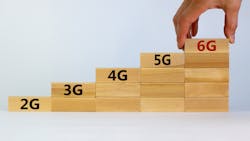This article is part of the 2023 Electronic Design Technology Forecast issue.
What you'll learn:
- 6G and its potential impact on upcoming events.
- How 6G will be a perfect fit for the Gen-Z population.
- Challenges with spectrum.
6G is on the horizon and its feature set will open new communication opportunities and address the continued demand for faster and more responsive wireless applications.
The new Olympic sport is the metaverse. The 2028 Summer Games will welcome 6G to the global stage. As a worldwide Olympic partner, expect Samsung to unveil a 6G deployment that will be a pivotal part of how viewers consume events. For example, you can expect one of the two Opening Ceremonies to happen in the metaverse.
Aggressive showcase objectives will become more visible, too. For example, the Japanese government plans to make the 2025 Osaka World Expo more visible as a 6G showcase.
The metaverse also will feature prominently in the user experience, enabling fans to participate in some Olympic events. In addition, we’ll see certain sports and, potentially, eSports run a 6G Metaverse Olympics in parallel with the actual Games, with at least one medal awarded within the metaverse. As brands draw inspiration from the Olympics, there will be a subsequent explosion of 6G use cases throughout 2028.
The arrival of 6G will open the door to new mobile network operators in the US. The tier one mobile network operators in the US have enjoyed a relatively stable market, but that is poised to change with the arrival of 6G. Similar to how Google Fiber enabled the company to enter into the ISP landscape, I think we’ll see Amazon, Microsoft, or another member of Big Tech capitalize on 6G to become a new tier one mobile network operator.
Ever used a Blackberry? Then 6G isn’t for you. 6G could be the sweet spot for Gen Z and the younger audience. The network is being built and set up for those currently 25 and under. These individuals are digital natives and they have no reservations about participating in virtual groups or sharing everything online. In 2023 and beyond, expect to see more discussion about how these younger generations will be monetized in 6G.
6G will foster a more geographically inclusive world, but it comes at a cost. Rural areas and remote industries like rail, offshore drilling, or broad mining will benefit from the enhanced connectivity of 6G. In addition, the network's ultra-low latency will further accelerate high-speed finance. But these and other 6G benefits will come at a cost, as the technology will be far more expensive than its predecessors. Given this, you can expect adoption disparities.
Spectrum challenges will be a gatekeeper to further network innovation. 6G is coming and, while much work remains to actualize its potential, we have enough bandwidth to make it happen. Still, the industry is running short on spectrum, which will ultimately become a barrier to future technologies. As such, expect the 2030s to focus on solving the spectrum challenges to allow for future network innovations to thrive.
6G (and 5G) spectrum discussion at FCC will be even more heated—the conflict in the 12-GHz bands, either under Notice of Proposed Rulemaking (NPRM) or Notice of Inquiry (NOI), will grow as the industries wrangle over how spectrum will be managed in the next decade.
The current (misplaced) criticism about 5G not meeting expectations will begin to temper given the growing deployment of Rel-16 and early deployment of Rel-17 capabilities. These will enable the fuller realization of the original 5G vision.
The ITU will release the radio figures of merit for 6G as part of the ITU-R WP-5D 6G vision work. This will lay the groundwork for the targets that the industry must meet for the specifications to be worthy of IMT-2030
5G FR2/mmWave will grow, though slowly because the standard still requires more improvements in the standard, and the gradual reduction of cost of deployment.
What will not happen: No standards work will start on 6G. And it’s not likely they will start in 2024, either. This isn’t bad—6G is in research and there’s plenty of 5G standards work to be completed before the first study items for 6G begin.
Agreement will not happen on the killer use case for 6G either. China will not allocate FR2 spectrum. This will wait until 2024, at least.
Read more articles in the 2023 Electronic Design Technology Forecast issue.


